Viburnum: Grow & Care for Viburnum Shrub
Written by Iris
Aug 13 2021
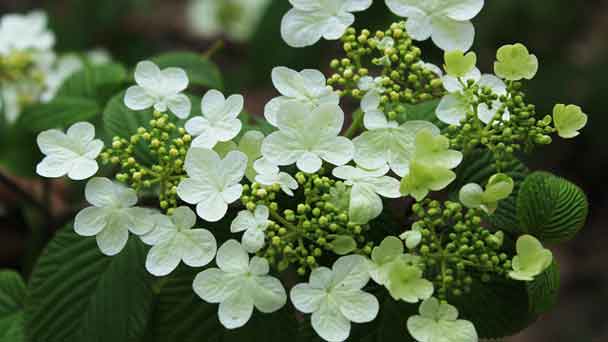
Viburnum is mainly native to Europe, America, and North Asia, but it also grows well in temperate parts of Australia. With over 150 plants, planting one of them can add interest and color to your garden for most of the year. They can be deciduous or evergreen, but what makes viburnum similar is the way the small flowers come together, like an umbrella. It's called a inflorescence or corymbo, with pink, white, or cream-colored flowers tightly packed together.
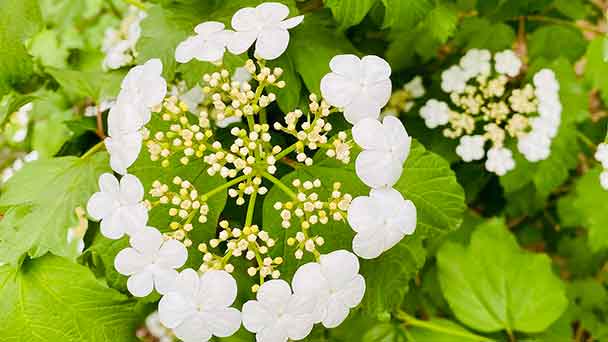
To do so, place the seeds in wet sand, inside a sealed plastic bag, and store them between 76 to 86 degrees.
Next, you'll need to cold stratify your seeds, mimicking a winter environment by placing the sealed bag in a refrigerator for 3 months and opening the bag once a week to exchange air. Follow this cold stratification with another period of warm stratification, which will break the seeds' dormancy. Seeds can then be sown 1/4” to 1/2” deep in either prepared seedbeds or native soil and should germinate the second spring after planting.
Place your cuttings in a container with good quality compost and lightly water them. They will need some light, but it's not recommended to keep them in direct sunlight. Using a propagator would be ideal. The cuttings should become established in 5-10 weeks.
Steps for Viburnum Propagation with Layers
Layering is a very easy way of propagating viburnum and simply means taking a stem from an existing plant and encouraging it to form its own roots. There are a few ways to accomplish this, but we’ll look at the simplest here.
Check the outside of your plants for stems that can be bent to the soil level. You should then make a small incision in the stem and bury it in the soil. Everything being well, this stem should form its own roots in 1-2 months. Once it's well established, you can then transplant it elsewhere in your garden, so it has room to flourish.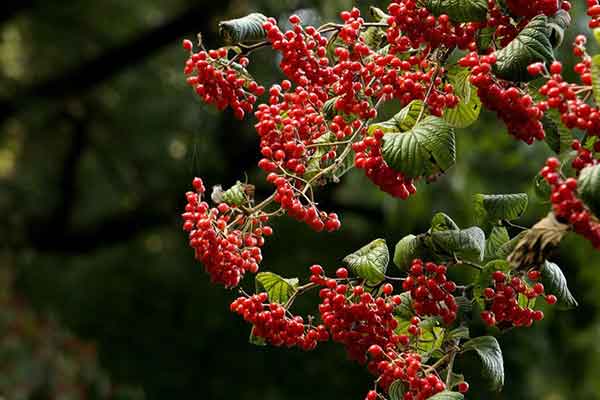
Also, think about the natural growth habit of the particular type of viburnum that you're planning to prune. If it has a naturally upright habit, don't try to prune it into a ball. If it has a spreading habit, don't try to prune it into an upright shrub. Whenever possible, simply prune to remove crossing, dead, or diseased branches. If you're looking for a lot of fresh growth, it's okay to prune one-third of the branches down to the base of the shrub each year, a process that renews and reinvigorates the shrub with new, fresh growth. Again, though, this isn't necessary.
Powdery mildew can show up on leaves, but don’t spray with sulfur-based sprays lest you damage the leaves.
The viburnum leaf beetle is an invasive bug from Asia and Europe that was introduced to North America in the late 1970s in Canada. It’s making its way south and causing a lot of damage to viburnum, devouring every leaf on a tree. Spray the larva with pesticides as soon as you spot them on the foliage.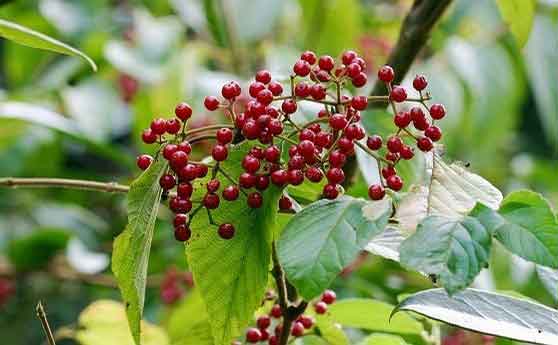
'Blue Muffin' viburnum is a compact type of Arrowwood viburnum. It gets 4' to 7' tall and produces intense blue fruit in the fall.
'Anne Russell' grows 6' to 8' high. It’s a type of Burkwood viburnum that produces white snowballs of flowers with a spicy scent in the spring and red fruit in the fall.
'Korean Spice' viburnum is native to Korea and Japan but is an old Southern favorite. It’s a bushy shrub with very fragrant white flowers in spring and dark green leaves that darken to red in the fall. It grows up to 6 feet tall.
'Chinese Snowball' viburnum is another Southern favorite, beloved for its fragrant white flowers that measure 5" to 8" across. It grows to 12 feet tall on average but can reach 20 feet in the warmest parts of its growing range.
'David' viburnum is an evergreen with glossy, dark green leaves. It's a small variety that gets 3' to 4' tall and is best suited to mild climates like the Pacific Northwest.
'Nanum' is a dwarf variety that stays under 3 feet tall. It makes white snowball flowers but rarely produces fruit.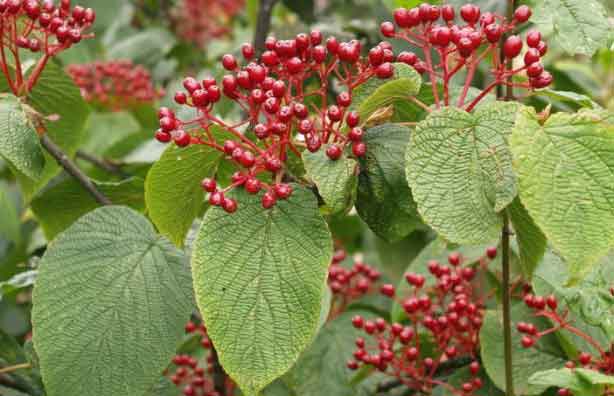
How to Choose and Prepare a Planting SiteWhen to Grow ViburnumHow to Grow ViburnumHow to Care for ViburnumVarieties of ViburnumViburnum FAQ
How to Choose and Prepare a Planting Site
Although the site requirements don’t vary too much between varieties, there may be subtle differences. As a general rule, full sun will produce the best blooms, berries and fall color. Some will do just as well in partial shade, especially some of the thicker-leaved varieties, but keep an eye out for black spot and other foliar diseases. They like to keep their foliage dry, so avoid planting where they might be subject to sprinkler overspray. Good air circulation is important to keep them from developing fungal diseases, but do protect them from drying winter winds.When to Grow Viburnum
Plant viburnums in the spring or early fall. As long as they have the chance to establish good root systems before temperatures either get really hot or freezing cold, they'll be fine.
How to Grow Viburnum
Steps for Viburnum Propagation with Seeds
Growing viburnum shrubs from seed is a lengthy process, as they can take up to 18 months to germinate. You should start your seeds by warm stratifying them, mimicking a warm, summer environment for two months.To do so, place the seeds in wet sand, inside a sealed plastic bag, and store them between 76 to 86 degrees.
Next, you'll need to cold stratify your seeds, mimicking a winter environment by placing the sealed bag in a refrigerator for 3 months and opening the bag once a week to exchange air. Follow this cold stratification with another period of warm stratification, which will break the seeds' dormancy. Seeds can then be sown 1/4” to 1/2” deep in either prepared seedbeds or native soil and should germinate the second spring after planting.
Steps for Viburnum Propagation with Stem Cuttings
Using cuttings is another way to propagate. Early summer is the best time to take cuttings. Be sure to use cuttings that haven't yet flowered and take from plants that are well watered.Place your cuttings in a container with good quality compost and lightly water them. They will need some light, but it's not recommended to keep them in direct sunlight. Using a propagator would be ideal. The cuttings should become established in 5-10 weeks.
Steps for Viburnum Propagation with Layers
Layering is a very easy way of propagating viburnum and simply means taking a stem from an existing plant and encouraging it to form its own roots. There are a few ways to accomplish this, but we’ll look at the simplest here.
Check the outside of your plants for stems that can be bent to the soil level. You should then make a small incision in the stem and bury it in the soil. Everything being well, this stem should form its own roots in 1-2 months. Once it's well established, you can then transplant it elsewhere in your garden, so it has room to flourish.

How to Care for Viburnum
Light
The light preferences of viburnum can range from full sun to mostly shade, depending on the variety. However, most viburnum bloom best when exposed to a few hours of full sun, each day. Planting viburnum where they can receive full morning sun but afternoon shade will ensure healthy blooming while protecting them from the hottest part of the day.Soil
Most viburnum grows best in moist and well-drained soils and typically prefer slightly acid soil conditions, with a pH between 5.5 and 6.6. As such, you may need to amend your native soil before planting viburnum in it. If your soil is too acidic, you can raise its pH by adding pelletized limestone. Conversely, applying soil sulfur, aluminum sulfate, or chelated iron can lower the pH of your soil, as can using organic compost.Water
When you first plant viburnums, water every 1 or 2 days, whenever the top inch of soil is dry. Hold the hose near the root ball and make sure the root zone is thoroughly soaked at each watering. You’ll be able to gradually increase the days between watering as the plants establish roots. Once viburnums have been in the ground for a year, they’ll mainly need extra water if your area has gone without rain for 3 to 4 weeks. Keep an eye on the plants during such dry spells. If the leaves look droopy or have a greyish cast to them, water them until regular precipitation returns.Temperature and Humidity
Viburnums prefer moderate conditions, though the preferences vary greatly depending on species. Extremely hot weather requires extra watering, and very cold temperatures can stunt the plant or cause dieback.Fertilizer
To maintain good foliage color and heavy bloom, and support growth and overall health of the plant, feed your Viburnums growing in the ground after they bloom with a slow-release shrub & tree food. Alternatively, you can feed with natural organic plant food. To avoid stimulating new growth that could be damaged by an early frost, cease fertilization two months prior to the first frost date in your area.Pruning
Most viburnums don't need pruning. That being said, if you want to prune your viburnums, do so right after they finish flowering. Viburnums bloom on old wood, meaning they form new flower buds during the summer that will open the following spring. If you prune viburnums in the late summer or winter, you'll cut off the spring flowers.Also, think about the natural growth habit of the particular type of viburnum that you're planning to prune. If it has a naturally upright habit, don't try to prune it into a ball. If it has a spreading habit, don't try to prune it into an upright shrub. Whenever possible, simply prune to remove crossing, dead, or diseased branches. If you're looking for a lot of fresh growth, it's okay to prune one-third of the branches down to the base of the shrub each year, a process that renews and reinvigorates the shrub with new, fresh growth. Again, though, this isn't necessary.
Pests and Diseases
Viburnum is considered pest-free plants, but they can still have problems.Powdery mildew can show up on leaves, but don’t spray with sulfur-based sprays lest you damage the leaves.
The viburnum leaf beetle is an invasive bug from Asia and Europe that was introduced to North America in the late 1970s in Canada. It’s making its way south and causing a lot of damage to viburnum, devouring every leaf on a tree. Spray the larva with pesticides as soon as you spot them on the foliage.

Varieties of Viburnum
Viburnums range from 3-foot-tall shrubs to 15-foot-tall trees. Here are some of our favorites.'Blue Muffin' viburnum is a compact type of Arrowwood viburnum. It gets 4' to 7' tall and produces intense blue fruit in the fall.
'Anne Russell' grows 6' to 8' high. It’s a type of Burkwood viburnum that produces white snowballs of flowers with a spicy scent in the spring and red fruit in the fall.
'Korean Spice' viburnum is native to Korea and Japan but is an old Southern favorite. It’s a bushy shrub with very fragrant white flowers in spring and dark green leaves that darken to red in the fall. It grows up to 6 feet tall.
'Chinese Snowball' viburnum is another Southern favorite, beloved for its fragrant white flowers that measure 5" to 8" across. It grows to 12 feet tall on average but can reach 20 feet in the warmest parts of its growing range.
'David' viburnum is an evergreen with glossy, dark green leaves. It's a small variety that gets 3' to 4' tall and is best suited to mild climates like the Pacific Northwest.
'Nanum' is a dwarf variety that stays under 3 feet tall. It makes white snowball flowers but rarely produces fruit.

Viburnum FAQ
Are Viburnum Poisonous to Dogs and Cats?
Although some berries from plants are poisonous to dogs and cats, viburnum is deemed safe for pets. It is important to remember that ingestion of any plant material may cause stomach upset in your cat or dog.Are Viburnum Berries Edible?
Viburnum berries are edible. With so many varieties of viburnum, the fruit of the plant can range from awful tasting to tasting very good. Among the consumed Viburnums are Viburnum alnifolium, Viburnum cassinoides, Viburnum edule, Viburnum lantana, Viburnum lentago, Viburnum nudum, Viburnum opulus, Viburnum prunifolium, Viburnum rufidulum, Viburnum setigerum, and Viburnum trilobum. Before you decide to taste or cook with the berries, it is best to do a bit of homework on the type of viburnum you have in your garden.
Latest Updated
- Benefits of Bugleweed - 7 Science-backed Health Benefits
- Bugleweed Dangers & Side Effects - Is It Poisonous?
- How to Plant Evergreen Trees - What You Should Know
- When to Plant Evergreens - Grow Guide for Evergreen Trees
- 12 Wonderful Evergreen Shrubs for Your Garden
- 12 Popular Evergreen Plants with Pictures for Beginners
- When And How To Prune A Lilac Bush Like a Pro
- How to Grow & Care for Lilac Vine (Hardenbergia Violacea)
- Japanese Lilac Tree (Syringa Reticulata) Care & Propagation Guide
- Shumard Oak Pros and Cons - What to Know
Popular Articles
- Winter maintenance of Antirrhinum Majus
- How to Grow Terminalia Mantaly Tree
- How to Grow and Care for Crossostephium Chinense
- How to grow Antirrhinum Majus in spring
- Peristeria Elata (Dove Orchid) Profile: Info & Care Guide
- Underwatered Snake Plant (Sansevieria Trifasciata) - Signs And How To Fix
- How to Care for Brazilian Jasmine Plant (Mandevilla Sanderi)
- How to Grow & Care for Graptopetalum Purple Delight in Summer
- Rosa Chinensis (China Rose): Plant Growing & Care Tips
- How to Care for Baby Sun Rose (Aptenia Cordifolia)